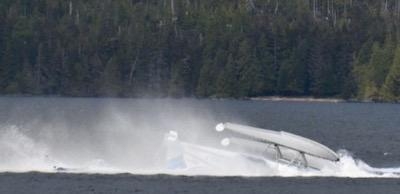Two Fatally Injured When Plane Flipped Over In The Water After Landing
The NTSB has released its preliminary report from an accident which occurred on May 20, 2019, about 1556 Alaska daylight time. A float-equipped de Havilland DHC-2 (Beaver) airplane, N67667, overturned and partially sank during a landing in Metlakatla Harbor, Metlakatla, Alaska. The commercial pilot and passenger sustained fatal injuries, and the airplane sustained substantial damage.

The airplane was registered to Blue Aircraft, LLC and operated by Venture Travel, LLC, dba Taquan Air, Ketchikan, Alaska, under the provisions of Title 14 Code of Federal Regulations Part 135 as a scheduled commuter flight. Company flight following procedures were in effect and visual meteorological conditions prevailed. The flight originated from the Ketchikan Harbor Seaplane Base (5KE), Ketchikan, about 1540 as Flight 20, and was destined for the Metlakatla Seaplane Base (MTM) in Metlakatla.
According to company dispatch documents, Flight 20 was a scheduled flight with one passenger, U.S. mail, freight and packages destined for Metlakatla, which is a community on Annette Island about 16 miles southeast of Ketchikan.
A preliminary review of archived Federal Aviation Administration (FAA) air traffic control track data revealed that after departure from Ketchikan, the flight traveled southeast over an area known as the Tongass Narrows, then south to Metlakatla Harbor. The end of the flight track indicated a right turn to a westward track in the southern portion of the harbor.
Three eyewitnesses provided statements to the National Transportation Safety Board (NTSB) investigator-in-charge (IIC). All three witnesses reported that the airplane made a normal approach to the water, in a westerly direction.
Two of the witnesses awaiting the arrival of Flight 20, stated that before touchdown on the surface of the water, the wings rocked to the left, and then to the right. One of the witnesses observed the right wing strike the surface of the water, and the airplane nosed over rapidly. After the airplane nosed over, the cockpit and cabin partially sank. The third witness, who was in a fishing vessel north of the accident site, said that as he watched the airplane land, he observed the right float "dig into the water" and then the airplane nosed over.

Two boats in the area immediately responded, followed by a Metlakatla Police vessel with volunteer emergency medical technicians (EMTs) onboard. According to statements provided by the first responders, the airplane's empennage was hoisted slightly out of the water by the fishing vessel, and good Samaritans together with the EMTs removed airplane seats, mail, packages and cargo netting. The occupants were removed from the airplane and transported to the Annette Island Health Center where they were declared deceased.
On May 21, during the NTSB IIC's on scene examination of the wreckage, it was revealed that the right wing and right lift strut separated from the fuselage in a rearward direction. Witnesses stated that the right wing and strut sank, as well as the passenger's seat after removal, and those components remain missing. All other major aircraft components were intact and accounted for. Several avionics components were subsequently recovered from the wreckage and sent to the NTSB Vehicle Recorders Laboratory in Washington, D.C. for further examination.
According to Taquan Air management personnel, the accident pilot was a new seasonal pilot hired for the 2019 season, and he held a commercial pilot certificate with airplane single-engine land, single-engine sea, and instrument airplane ratings. According to the operator, when the pilot started company orientation on April 22, he had a total of 1,606 flight hours, of which 5 hours were in float-equipped airplanes. He completed the company CFR Part 135.293 and 135.299 check rides in a float-equipped DHC-2 on May 3, and he completed CFR Part 135.244 initial operation experience requirements on May 11, 2019.
The closest weather reporting facility is located at the Annette Island Airport (PANT), about 6 miles south of the accident site. At 1553 an aviation routine weather report (METAR) reported wind from 160° at 10 knots, visibility 10 statute miles, ceiling and cloud cover clear, temperature 55° F, dew point 48° F, and altimeter 29.71 inches of mercury. Witnesses near the accident site stated that the wind conditions were from the southeast, from the direction of Purple Mountain, at 13 to 15 mph, and that the water conditions were less than choppy.
(Images provided to the NTSB by accident witness Nicholas King)
 ANN's Daily Aero-Term (04.20.24): Light Gun
ANN's Daily Aero-Term (04.20.24): Light Gun Aero-News: Quote of the Day (04.20.24)
Aero-News: Quote of the Day (04.20.24) ANN's Daily Aero-Linx (04.21.24)
ANN's Daily Aero-Linx (04.21.24) Aero-News: Quote of the Day (04.21.24)
Aero-News: Quote of the Day (04.21.24) ANN's Daily Aero-Term (04.21.24): Aircraft Conflict
ANN's Daily Aero-Term (04.21.24): Aircraft Conflict




